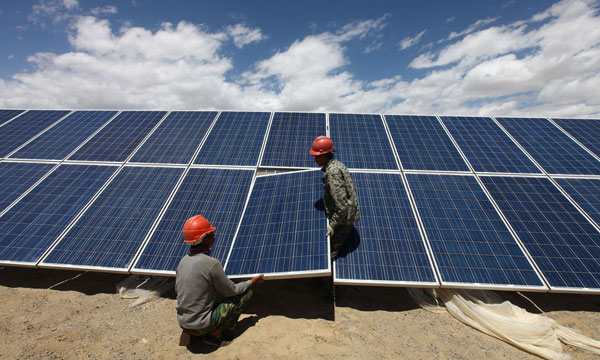Current climate treaties a lot of hot air
Updated: 2015-11-30 07:42
By Bjorn Lomborg(China Daily)
|
||||||||
 |
|
Workers install a solar panel at a photovoltaic power station in Aleteng village, northwest China. Job creation is an example of an economic co-benefit of tackling climate change. Photograph: REX/Imaginechina/REX/Imaginechina |
Paris is hosting the 21st global climate conference, and there are high hopes that negotiators will agree on a carbon-cutting treaty. But adding up the climate effects and costs of carbon-cutting commitments shows that there is something very wrong with this approach.
In a peer-reviewed research paper, I looked at the promises governments have committed to ahead of Paris (their so-called Intended Nationally Determined Contributions) for the years 2016-2030. These are what the global treaty will be based on.
By running this data through internationally recognized climate models, I found that the promises will cut global temperatures by just 0.05 degrees Celsius by 2100.China's contribution would be a 0.014 Creduction by 2100.
I also explored a far more optimistic, much less likely scenario. What if every government not only keeps every Paris promise but also shifts no emissions to other countries and keeps these reductions throughout the rest of the century? In that artificial scenario, temperatures will be reduced by just 0.17 C by 2100(with China contributing 0.048 C).
The United Nations Framework Convention on Climate Change claims "the INDCs have the capability of limiting the forecast temperature rise to around 2.7 C by 2100". This is advocacy, not science. It essentially assumes governments will do relatively little in Paris, but right after 2030 will embark on much more ambitious climate reductions.
Let us get back to reality. What will it cost to cut global temperatures by so little?
We can add up the price tags for the Paris promises submitted by the United States, the European Union, Mexico and China, which account for about 80 percent of pledged reductions.
The US promises to cut greenhouse gas emissions 26-28 percent below 2005 levels by 2025. Data from the peer-reviewed Stanford Energy Modeling Forum shows hitting the target would reduce GDP between $154 billion and $172 billion annually. The EU's promise-to cut emissions 40 percent below 1990 levels by 2030-would reduce GDP by 1.6 percent in 2030, or 287 billion ($305.68 billion) in terms of the value in 2010.Mexico's conditional promise to cut greenhouse gas and black carbon emissions by 40 percent below the current trend line would reach 4.5 percent of GDP by 2030.
- Xi arrives in Paris for climate change summit
- The price of inaction: runaway climate change
- China shows commitment in fighting climate change: French FM
- China leads the way in South-South climate change cooperation
- Xi's visits mark new era of global climate change campaign, China-Africa cooperation
- Climate change, artificial intelligence and being disabled 气候变化,人工智能和残疾舞蹈演员
- What I expect from climate change conference
- Xi to deliver climate change plan in Paris
- Keep climate change from impoverishing millions
- Global health entering new era: WHO chief
- Brazil's planning minister steps aside after recordings revelation
- Vietnam, US adopt joint statement on advancing comprehensive partnership
- European border closures 'inhumane': UN refugee agency
- Japan's foreign minister calls A-bombings extremely regrettable
- Fukushima impact unprecedented for oceans: US expert

 Stars of Lijiang River: Elderly brothers with white beards
Stars of Lijiang River: Elderly brothers with white beards
 Wealthy Chinese children paying money to learn British manners
Wealthy Chinese children paying money to learn British manners
 Military-style wedding: Fighter jets, grooms in dashing uniforms
Military-style wedding: Fighter jets, grooms in dashing uniforms
 Striking photos around the world: May 16 - May 22
Striking photos around the world: May 16 - May 22
 Robots help elderly in nursing home in east China
Robots help elderly in nursing home in east China
 Hanging in the air: Chongqing holds rescue drill
Hanging in the air: Chongqing holds rescue drill
 2.1-ton tofu finishes in two hours in central China
2.1-ton tofu finishes in two hours in central China
 Six things you may not know about Grain Buds
Six things you may not know about Grain Buds
Most Viewed
Editor's Picks

|

|

|

|

|

|
Today's Top News
Liang avoids jail in shooting death
China's finance minister addresses ratings downgrade
Duke alumni visit Chinese Embassy
Marriott unlikely to top Anbang offer for Starwood: Observers
Chinese biopharma debuts on Nasdaq
What ends Jeb Bush's White House hopes
Investigation for Nicolas's campaign
Will US-ASEAN meeting be good for region?
US Weekly

|

|







